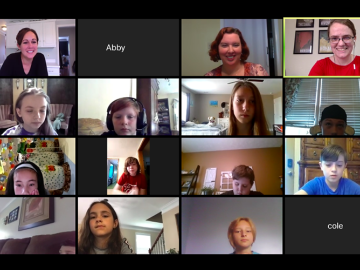
Filter News
Area of Research
- (-) Materials (25)
- (-) Supercomputing (49)
- Advanced Manufacturing (2)
- Biology and Environment (40)
- Biology and Soft Matter (1)
- Computational Biology (1)
- Electricity and Smart Grid (1)
- Energy Science (35)
- Fusion and Fission (8)
- Materials for Computing (2)
- National Security (15)
- Neutron Science (55)
- Nuclear Science and Technology (6)
- Quantum information Science (1)
News Topics
- (-) Advanced Reactors (1)
- (-) Artificial Intelligence (22)
- (-) Big Data (16)
- (-) Grid (3)
- (-) Neutron Science (14)
- (-) Physics (13)
- 3-D Printing/Advanced Manufacturing (5)
- Bioenergy (5)
- Biology (6)
- Biomedical (8)
- Biotechnology (1)
- Buildings (3)
- Chemical Sciences (7)
- Clean Water (2)
- Composites (2)
- Computer Science (48)
- Coronavirus (7)
- Cybersecurity (2)
- Energy Storage (7)
- Environment (19)
- Exascale Computing (16)
- Frontier (17)
- Fusion (2)
- High-Performance Computing (25)
- Isotopes (7)
- Machine Learning (8)
- Materials (21)
- Materials Science (20)
- Mathematics (2)
- Microscopy (7)
- Nanotechnology (9)
- National Security (3)
- Nuclear Energy (11)
- Partnerships (3)
- Polymers (4)
- Quantum Computing (12)
- Quantum Science (11)
- Security (3)
- Simulation (12)
- Software (1)
- Space Exploration (2)
- Summit (22)
- Transportation (7)
Media Contacts

In the search to create materials that can withstand extreme radiation, Yanwen Zhang, a researcher at the Department of Energy’s Oak Ridge National Laboratory, says that materials scientists must think outside the box.

Scientists at the Department of Energy Manufacturing Demonstration Facility at ORNL have their eyes on the prize: the Transformational Challenge Reactor, or TCR, a microreactor built using 3D printing and other new approaches that will be up and running by 2023.

Research by an international team led by Duke University and the Department of Energy’s Oak Ridge National Laboratory scientists could speed the way to safer rechargeable batteries for consumer electronics such as laptops and cellphones.

With Tennessee schools online for the rest of the school year, researchers at ORNL are making remote learning more engaging by “Zooming” into virtual classrooms to tell students about their science and their work at a national laboratory.

In the race to identify solutions to the COVID-19 pandemic, researchers at the Department of Energy’s Oak Ridge National Laboratory are joining the fight by applying expertise in computational science, advanced manufacturing, data science and neutron science.

We have a data problem. Humanity is now generating more data than it can handle; more sensors, smartphones, and devices of all types are coming online every day and contributing to the ever-growing global dataset.

As the second-leading cause of death in the United States, cancer is a public health crisis that afflicts nearly one in two people during their lifetime.

Scientists at have experimentally demonstrated a novel cryogenic, or low temperature, memory cell circuit design based on coupled arrays of Josephson junctions, a technology that may be faster and more energy efficient than existing memory devices.

Researchers across the scientific spectrum crave data, as it is essential to understanding the natural world and, by extension, accelerating scientific progress.

For nearly three decades, scientists and engineers across the globe have worked on the Square Kilometre Array (SKA), a project focused on designing and building the world’s largest radio telescope. Although the SKA will collect enormous amounts of precise astronomical data in record time, scientific breakthroughs will only be possible with systems able to efficiently process that data.


